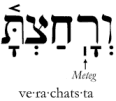|
Qamets Chatuph appears 630 times in the Tanakh (Hebrew Bible) and occurs only in closed, unaccented syllables:

Qamets or Qamets Chatuph?
When you see a Qamets, you must ask 1) is it in a closed syllable? (i.e., a syllable that ends in a stopping sound) and 2) is the syllable unaccented? (most Hebrew words are accented on the last syllable). If both conditions are met, the Qamets is Chatuph and should be pronounced as an "o" sound. For example:

In the example above, the last syllable is closed (it ends in Mem) and is unaccented, and thus the vowel is Qamets Chatuph: kom.
Generally speaking, whenever you see the Qamets vowel mark you should assume that it is pronounced "ah." In ambiguous cases, sometimes a small vertical mark (called a Meteg mark) appears just to the left of the Qamets to indicate that it is an open syllable and should be pronounced "ah" and not "o":

Return to Unit Three
|


